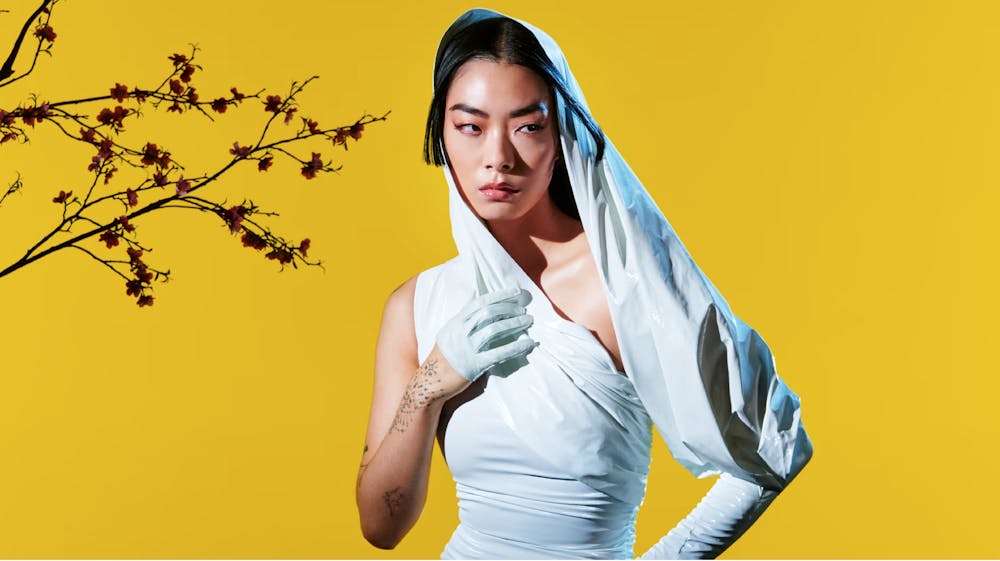To anyone who has heard Rina Sawayama’s soaring vocals or witnessed her magnetic stage presence, it is a mystery why she hasn’t blown up yet. Part of the answer may lie in the less-than-ideal circumstances that clouded her stellar debut album “SAWAYAMA,” released in April 2020 during the onset of the pandemic. With “SAWAYAMA,” the 32-year-old Japanese-British singer-songwriter exploded onto the music scene with a genre-bending sound and incisive lyrics that grappled with intergenerational trauma, consumerism and racial microaggressions. However, due to pandemic restrictions, Sawayama’s fans could only reciprocate that energy through social media. Now, on her sophomore album “Hold the Girl,” Sawayama invites listeners to unpack their emotional baggage and leave it all on the dance floor.
The album opens with a contemplative two-minute track titled “Minor Feelings,” which takes its name from a book of essays written by Korean-American poet Cathy Park Hong. In the book, Hong spotlights the feelings of marginalization and inferiority experienced by minority groups in predominantly white spaces, feelings that are often dismissed as “minor” because they contradict the cultural narrative. In the context of “Hold the Girl,” the term takes on an additional meaning: Sawayama is reckoning with the feelings of isolation, repression and powerlessness that she experienced as a young girl, which have accumulated and are now “majorly breaking her down”. Sawayama also recognizes the dire consequences of suppressing these “minor feelings” on a societal level, alluding to the surge in anti-Asian hate crimes fueled by the pandemic in the song’s first verse. While “Minor Feelings” does not pack quite a punch compared to “Dynasty” — the anthemic opening track to her debut album “SAWAYAMA” — it succinctly establishes the thesis for the record and hints at themes to come.
If “Minor Feelings” lays out Sawayama’s deep-rooted trauma, the two songs that follow it are a rallying cry for anyone who has ever felt similarly vulnerable or marginalized because of their identity. On “Hold the Girl,” the album’s title track, Sawayama pairs an infectious two-step beat with heartfelt lyrics speaking to her younger self, giving her the support and reassurance that she lacked all those years ago. In an interview with People Magazine, Sawayama revealed that the idea for the song came to her after an intense therapy session in which she envisioned herself reparenting and holding her traumatized inner child, a concept that also inspired the album’s cover art.
Sawayama keeps the party going with “This Hell,” an irreverent ode to all queer people who have been told that they’re going to hell because of their sexual orientation. Blending iconic cultural references (“Wow, that’s hot”) with interpolations of ABBA and Bon Jovi, she boldly declares that she would rather dance in hell with her LGBTQ sisters and brothers than relinquish her queerness and gain entrance to a homophobic heaven.
In addition to the clear 80s influences, Sawayama experiments with a host of other genres on this album: she serves 2000s pop-rock on “Catch Me In the Air” and “Hurricanes,” country-pop on “Forgiveness” and the stripped-down “Send My Love to John” (think Lady Gaga’s “Joanne” era) and she packs in an epic glam rock guitar solo on “Phantom.”
The album’s most interesting and impressive stretch, though, is the four-track run from “Holy (Til You Let Me Go)” to “Frankenstein.” These songs explore the origins of Sawayama’s emotional turmoil, from toxic past relationships to her experiences enduring bullying, racism and depression while studying at Cambridge University from 2009 to 2012. On the electronic dark-pop track “Holy (Til You Let Me Go),” Sawayama realizes with resentment that the love she received as a youth was conditioned on her being “pure” and obscuring her pansexuality. “Your Age” jumps genres to nu metal but sustains the feelings of anger and disbelief from “Holy,” then “Imagining” turns the strobe lights back on for a frenzied hyperpop anthem that reflects the chaos and confusion of being in a manipulative relationship. To close off this stretch of the album, drummer Matt Tong (formerly part of the English rock band Bloc Party) takes the reins and drives “Frankenstein” with a 130-BPM drum track, as Sawayama frantically begs her significant other to patch up all her problems and make her feel beautiful. It’s maximalist, it’s intense, and it’s camp — but that’s exactly what Sawayama does best.
Get The Chronicle straight to your inbox
Signup for our weekly newsletter. Cancel at any time.

